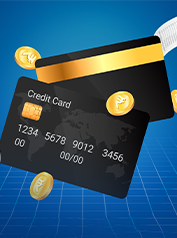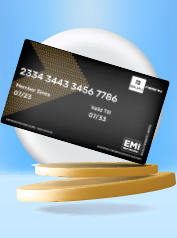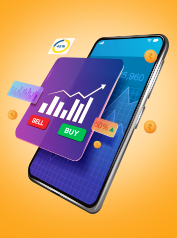Check out what the unbilled amount on a credit card is. Learn how to check this amount, how it differs from the outstanding amount, and the consequences you may face if you do not pay on time.
The meaning of unbilled credit card amount is the unprocessed expenses that have not yet been included in your credit card billing statement. Here is an example of how you can calculate the credit card unbilled amount:
You made a ₹5,000 transaction on 8th January and another ₹5,000 transaction on 12th January
Your credit card billing cycle ends on the 15th of each month
If you check your statement on 13th January, the ₹10,000 will appear as an unbilled amount
These purchases were made just before the billing cycle ended, so they will not appear on your January statement. Instead, they will be billed in the following statement.
Check your card’s unbilled amount to manage your finances better and repay the debt before the due date. Some of the methods you can use to check this amount are listed below:
You can check your statement online through the issuer’s net banking platform. By logging into your account and checking the statement, you can stay informed of your card spending limits and unbilled amounts.
When you receive your card, you may have registered your phone number for SMS alerts. Many issuers offer the option to receive your card statement via text message on your registered mobile number.
You typically receive your card statements via email once the billing cycle is complete. Regularly monitoring your statements will help you track your unbilled amount.
You can contact the customer service team if you prefer not to check your unbilled amount online. Many issuers offer the facility to inquire about your card statement via toll-free customer care numbers. Some services may only be available on weekdays.
In some cases, customer care chatbots on the website may also be able to assist you with this query.
You can also use your issuer’s mobile application to stay updated on your current unbilled amount. This is a simple option that allows you to check your statements without any hassle.
You can also check your unbilled credit card amount through a statement printed at a nearby ATM. This option provides a quick way to stay updated on your card’s usage when you are on the go.
Although they may seem the same, unbilled credit card amounts and outstanding amounts are two distinct terms. Check out the following table to better understand the differences between them.
Category |
Unbilled Amount |
Outstanding Amount |
|---|---|---|
Definition |
Transactions made but not yet included in the billing statement. These are carried forward to the next billing cycle. |
The unpaid balance from the previous billing cycle that remains due. |
Timing |
Occurs between two billing cycles and is added to the next cycle. |
Carries over from the previous statement if not fully paid. |
Impact on Bill |
Will not appear in the current month’s bill but in the next one. |
Needs to be paid within the due date to avoid interest charges |
This refers to the total transaction amount for purchases you have made but that have not yet been included in your credit card statement. Transactions between two billing cycles are added to the second month’s billing cycle.
For example, if your credit card billing cycle ends on the 15th of every month and you make purchases worth ₹20,000 on the 5th, these transactions will show as the unbilled amount in your statement until the 14th.
The outstanding amount is the balance you owe to the issuer from the previous billing cycle that remains unpaid.
Using the same example, if your credit card bill was due on the 15th of the month and you paid ₹15,000, the remaining ₹5,000 is the outstanding amount. You will have to pay this balance within the specified date.
Failing to pay the unbilled amount on your credit card by the due date can lead to several consequences. From late payment fees and poor credit scores to additional interest, unpaid amounts can quickly accumulate and negatively affect your financial standing.
Some of the other consequences include:
Issuers add unpaid unbilled amounts to the next billing cycle. This will increase your outstanding balance and total dues.
You may have to incur high interest rates of up to 3-4% per month on unpaid amounts.
Leaving unbilled amounts unpaid can harm your credit score over time. Your credit utilisation ratio will rise, which makes you look slightly unreliable with credit.
Late payment charges will apply as a penalty for unpaid amounts.
Unpaid credit card dues will reduce your available credit. This may limit your ability to use your card for emergencies in the future.
Continuously failing to repay your credit card bills may result in suspension of your credit card. This can damage your credit profile.
Yes, you must pay the unbilled amount on your card when it appears in the next billing cycle. Pay the total dues before the due date to avoid penalties and other consequences.
Paying the unbilled amount before the due date will reduce the balance on your upcoming statement.
The unbilled amount will be charged to your next billing cycle and will appear on your upcoming statement, adding to your total balance due. This may affect your credit utilisation ratio.
Yes, there are penalties for not paying the unbilled amount when it is a part of your total credit card bill. You may need to pay late fees or interest on the unpaid balance.
Yes, many credit card issuers offer the option to set up notifications or alerts for changes to your unbilled amount. These alerts can help you stay informed about your spending and avoid missed payments.
Transactions such as cash advances, online purchases, balance transfers, and any unprocessed charges are added to the unbilled amount. These charges may not reflect in your statement until they are processed.












